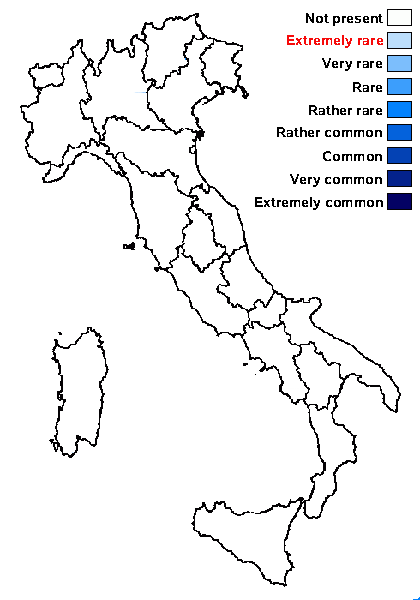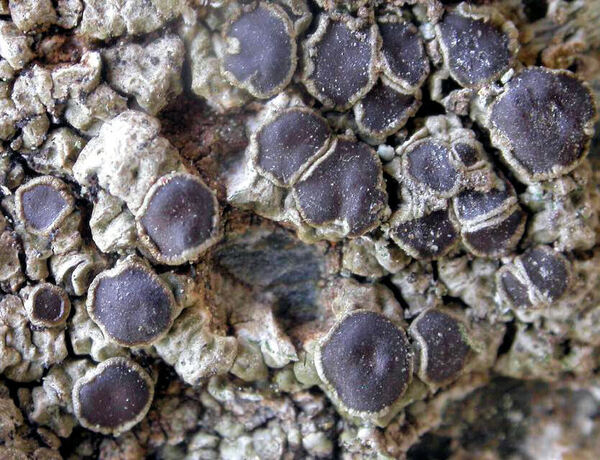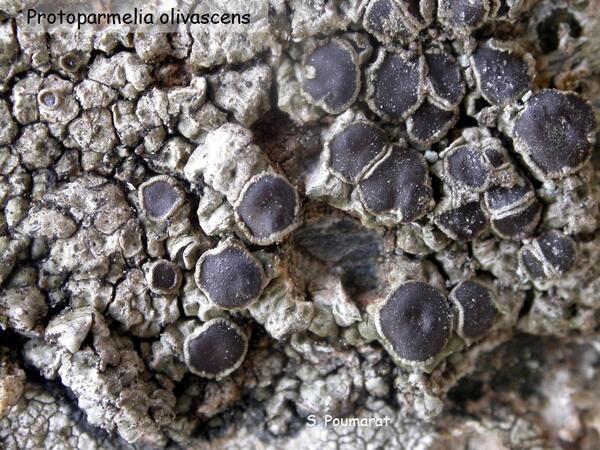Xanthoparmelia olivascens (Nyl.) V.J. Rico & G. Amo
in Amo de Paz & al., J. Fungi, 10, 9, no. 603: 7, 2024.. Basionym: Lecanora olivascens Nyl. - Bull. Soc. linn. Normandie, sér. 2, 6, 2: 263, 1872.
Synonyms: Protoparmelia olivascens (Nyl.) Llimona ex J.-M. Sussey
Distribution:
Description: Thallus apparently crustose-placodioid but actually subfoliose (with a lower cortex), heteromerous, areolate in central part, radially lobate in the margins, dark reddish brown to dark grey-brown or brown-black, sometimes paler in marginal parts, forming up to 3 cm wide patches, the lobes 0.2-2.5 mm long, 0.15-1.2 mm wide, linear elongate to ± deeply sinuate, branched at the ends, the longest ones with transverse cracks, mainly contiguous, convex but sometimes flattened at tips, the central areoles 0.3-1.5 mm wide, sometimes fissured, convex. Lower surface mainly black, brown, light brown to beige, dull, free or with simple, short, sparse rhizines or attached by tufts of rhizohyphae originating from the lower cortex. Upper cortex 7-37 μm thick, reddish-brown in upper part, paraplectenchymatous, with a gelatinous epicortex, N+ blue-green; medulla white, mainly of irregularly branched, pachydermatous hyphae covered with greyish crystals; lower cortex paraplectenchymatous. Apothecia lecanorine, adnate or sessile, up to 1.1 mm across, with a black to dark brown, dull, concave to slightly convex disc and a persistent, smooth to crenulate thalline margin. Proper exciple cupulate, 30-60 μm thick at mid-level; epithecium brown to reddish-brown, up to 20 µm high; hymenium colourless to ochraceous, 40-60 µm high; paraphyses coherent branched and anastomosing, the apical cells up to 8 μm wide; hypothecium thin, colourless to ochraceous. Asci 8-spored, Lecanora-type. Ascospores 1.celled, hyaline to faintly yellow-orange, narrowly ellipsoid, 12-17.5 (-23) x 4.5-7.5 μm, the wall 0.5-1 μm thick. Pycnidia frequent, immersed, up to 120 μm wide. Conidia simple, hyaline, narrowly fusiform, straight, 7-12 x 1-2 µm. Photobiont chlorococcoid. Spot tests: medulla K+ yellow turning red (needle-like crystals), C-, KC-, P+ yellow, Chemistry: norstictic acid (major), hyposalazinic, connorstictic, consalazinic acids (minor), subnorstictic and stictic acid (traces).Note: a mainly Mediterranean species of siliceous rocks; to be looked for in Mediterranean Italy. This lichen was usually assigned to Protopamelia owing to the brown, crustose thallus, but subsequent studies of morphology, secondary chemistry, and molecular data of the nuITS rDNA indicate that it belongs to Xanthoparmelia, fitting phylogenetically into a clade that was previously only known from the Southern Hemisphere (Amo de Paz & al. 2024).
Growth form: Crustose
Substrata: rocks
Photobiont: green algae other than Trentepohlia
Reproductive strategy: mainly sexual

Predictive model

Source: Amo de Paz G.. Divakar P.K.. Crespo A.. Lumbsch H.T.. Rico. V.J. 2024. The first miniature, small foliose, brown Xanthoparmelia in the Northern Hemisphere. J. Fungi, 10, 603. - CC BY 4.0
Xanthoparmelia olivascens, epitype (MAF-Lich. 25204), except c (MAF-Lich. 24759): (a) habit,
stacked; (b) section of apothecium margin, note the cupular proper excipulum (arrow), DIC, stacked;
(c) section of thallus areole, showing the medulla (left layer) and the lower cortex with raising
tufts of attaching rhizoidal hyphae (arrow), DIC, stacked; (d) lower surface with short rhizines
(arrows); (e) conidiophores, DIC; (f) conidia, DIC; (g) ascospores, DIC. Images by V.J. Rico. Scale bars:
(a) = 5 mm; (b) = 15 μm; (c) = 20 μm; (d) = 0.5 mm; and (e–g) = 5 μm.
Growth form: Crustose
Substrata: rocks
Photobiont: green algae other than Trentepohlia
Reproductive strategy: mainly sexual

Predictive model




